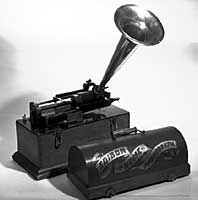
from http://memory.loc.gov and http://www.nps.gov:
Wax cylinder recording session, Thursday, October 30 at 7:00 pm
WEST ORANGE, NJ –On October 30, visitors to Thomas Edison National Historical Park will have the opportunity to watch and listen as the Demolition String Duo makes recording history. Elena Skye and Boo Reiners are the featured artists at a wax cylinder phonograph recording session taking place on Thursday evening.
Elena Skye and Boo Reiners lead New York City’s “Demolition String Band”. They are currently celebrating the release of their recording of the Woody Guthrie song “Go Coney Island, Roll on the Sand” on the audio book “My Name is New York, Ramblin’ Around Woody Guthrie’s Town”. This new audio book is a collection of Guthrie’s New York City-inspired stories and music, produced and narrated by daughter Nora Guthrie.
The Demolition String Duo will record onto wax cylinders in the same way it was done in Edison’s time over a century ago. The method of capturing sound is non-electric. Like the artists who recorded for Edison during the 1890s, the Demolition String Duo will play in front of a large horn that will serve as their microphone. The duo hopes to release the recordings they make at the Edison Laboratory on a future album.
The phonograph was developed as a result of Thomas Edison’s work on two other inventions, the telegraph and the telephone. In 1877, Edison was working on a machine that would transcribe telegraphic messages through indentations on paper tape, which could later be sent over the telegraph repeatedly. This development led Edison to speculate that a telephone message could also be recorded in a similar fashion. He experimented with a diaphragm which had an embossing point and was held against rapidly-moving paraffin paper. The speaking vibrations made indentations in the paper. Edison later changed the paper to a metal cylinder with tin foil wrapped around it.
The machine had two diaphragm-and-needle units, one for recording, and one for playback. When one would speak into a mouthpiece, the sound vibrations would be indented onto the cylinder by the recording needle in a vertical (or hill and dale) groove pattern. Edison gave a sketch of the machine to his mechanic,JohnKruesi, to build,whichKruesi supposedly did within 30 hours. Edison immediately tested the machine by speaking the nursery rhyme into the mouthpiece, “Mary had a little lamb.” To his amazement, the machine played his words back to him.Although it was later stated that the date for this event was on August 12, 1877, some historians believe that it probably happened several months later, since Edison did not file for a patent until December 24, 1877. Also, the diary of one of Edison’s aides, Charles Batchelor, seems to confirm that the phonograph was not constructed until December 4, and finished two days later.The patent on the phonograph was issued on February 19, 1878. The invention was highly original. The only other recorded evidence of such an invention was in a paper by French scientist Charles Cros, written on April 18, 1877. There were some differences, however, between the two men’s ideas, and Cros’s work remained only a theory, since he did not produce a working model of it.
Edison took his new invention to the offices of Scientific American in New York City and showed it to staff there. As the December 22, 1877, issue reported, “Mr. Thomas A. Edison recently came into this office, placed a little machine on our desk, turned a crank, and the machine inquired as to our health, asked how we liked the phonograph, informed us that it was very well, and bid us a cordial good night.” Interest was great, and the invention was reported in several New York newspapers, and later in other American newspapers and magazines.
The Edison Speaking Phonograph Company was established on January 24, 1878, to exploit the new machine by exhibiting it. Edison received $10,000 for the manufacturing and sales rights and 20% of the profits. As a novelty, the machine was an instant success, but was difficult to operate except by experts, and the tin foil would last for only a few playings.
This entry was posted on October 2, 2014 at 12:25 am and is filed under events, music history. You can follow any responses to this entry through the RSS 2.0 feed.
You can leave a response, or trackback from your own site.

Leave a comment